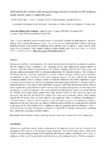Mostrar o rexistro simple do ítem
Birth-and-death evolution with strong purifying selection in the histone H1 multigene family and the origin of "orphon" H1 genes
| dc.contributor.author | Eirín-López, J.M. | |
| dc.contributor.author | González-Tizón, Ana M. | |
| dc.contributor.author | Martínez-Lage, Andrés | |
| dc.contributor.author | Méndez, Josefina | |
| dc.date.accessioned | 2019-04-01T17:10:39Z | |
| dc.date.available | 2019-04-01T17:10:39Z | |
| dc.date.issued | 2004-10 | |
| dc.identifier.citation | José M. Eirín-López, Ana M. González-Tizón, Andrés Martínez, Josefina Méndez, Birth-and-Death Evolution with Strong Purifying Selection in the Histone H1 Multigene Family and the Origin of orphon H1 Genes, Molecular Biology and Evolution, Volume 21, Issue 10, October 2004, Pages 1992–2003, https://doi.org/10.1093/molbev/msh213 | es_ES |
| dc.identifier.issn | 0737-4038 | |
| dc.identifier.uri | http://hdl.handle.net/2183/22454 | |
| dc.description.abstract | [Abstract:] Histones are small basic nuclear proteins with critical structural and functional roles in eukaryotic genomes. The H1 multigene family constitutes a very interesting histone class gathering the greatest number of isoforms, with many different arrangements in the genome, including clustered and solitary genes, and showing replication-dependent (RD) or replication-independent (RI) expression patterns. The evolution of H1 histones has been classically explained by concerted evolution through a rapid process of interlocus recombination or gene conversion. Given such intriguing features, we have analyzed the long-term evolutionary pattern of the H1 multigene family through the evaluation of the relative importance of gene conversion, point mutation, and selection in generating and maintaining the different H1 subtypes. We have found the presence of an extensive silent nucleotide divergence, both within and between species, which is always significantly greater than the nonsilent variation, indicating that purifying selection is the major factor maintaining H1 protein homogeneity. The results obtained from phylogenetic analysis reveal that different H1 subtypes are no more closely related within than between species, as they cluster by type in the topologies, and that both RD and RI H1 variants follow the same evolutionary pattern. These findings suggest that H1 histones have not been subject to any significant effect of interlocus recombination or concerted evolution. However, the diversification of the H1 isoforms seems to be enhanced primarily by mutation and selection, where genes are subject to birth-and-death evolution with strong purifying selection at the protein level. This model is able to explain not only the generation and diversification of RD H1 isoforms but also the origin and long-term persistence of orphon RI H1 subtypes in the genome, something that is still unclear, assuming concerted evolution. | es_ES |
| dc.description.sponsorship | Xunta de Galicia; PGIDT (10PX110304) | es_ES |
| dc.language.iso | eng | es_ES |
| dc.publisher | Oxford University Press | es_ES |
| dc.relation.uri | https://doi.org/10.1093/molbev/msh213 | es_ES |
| dc.subject | Birth-and-death evolution | es_ES |
| dc.subject | Purifying selection | es_ES |
| dc.subject | Concerted evolution | es_ES |
| dc.subject | Histone H1 | es_ES |
| dc.subject | Orphon genes | es_ES |
| dc.title | Birth-and-death evolution with strong purifying selection in the histone H1 multigene family and the origin of "orphon" H1 genes | es_ES |
| dc.type | info:eu-repo/semantics/article | es_ES |
| dc.rights.access | info:eu-repo/semantics/openAccess | es_ES |
| UDC.journalTitle | Molecular Biology and Evolution | es_ES |
| UDC.volume | 21 | es_ES |
| UDC.issue | 10 | es_ES |
| UDC.startPage | 1992 | es_ES |
| UDC.endPage | 2003 | es_ES |
Ficheiros no ítem
Este ítem aparece na(s) seguinte(s) colección(s)
-
GI-GIBE - Artigos [74]






